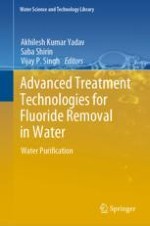2023 | OriginalPaper | Buchkapitel
5. Efficient and Cost Effective Groundwater De-fluoridation Adsorbents with Focus on Rural Hilly India: A Comprehensive Review
verfasst von : Rahul Singh Thakur, Ankit Modi
Erschienen in: Advanced Treatment Technologies for Fluoride Removal in Water
Verlag: Springer Nature Switzerland
Aktivieren Sie unsere intelligente Suche, um passende Fachinhalte oder Patente zu finden.
Wählen Sie Textabschnitte aus um mit Künstlicher Intelligenz passenden Patente zu finden. powered by
Markieren Sie Textabschnitte, um KI-gestützt weitere passende Inhalte zu finden. powered by
